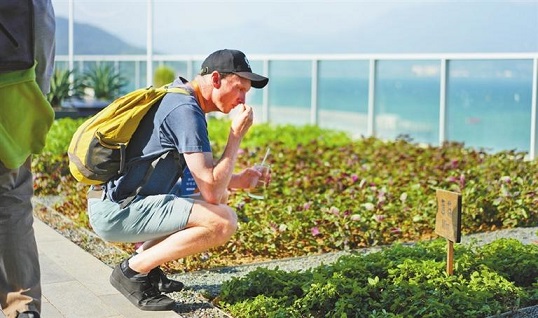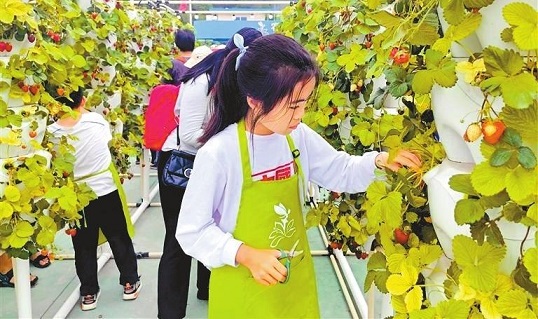Shenzhen
 2024/7/18
2024/7/18
 source: Shenzhen Daily
source: Shenzhen Daily
 Print
Print

An overview of the roof of a hotel supplies mall in Pinghu, Longgang District, which has been transformed into One Top, a space for leisure and recreational activities. The rooftop venue has become popular among online content creators, with a go-kart track, coffee shops, restaurants, and even a camping site. File photo

An expat appreciates herbs on the rooftop of the Yun Resort Shenzhen Longcheer in Dapeng New Area. Liu Xudong

Children collect strawberries on the roof of the Lily Flower Valley science base. Courtesy of the base
Wang Jingli
wangjingli0715@163.com
AMIDST the hustle and bustle of city life, many people are finding rooftops to be sanctuaries where they can clear their minds and breathe. As cities rapidly develop, modern rooftops are increasingly being used in new ways that go beyond their traditional functions.
Through meticulous transformations, some rooftops in Shenzhen now feature innovative designs and multifunctional capabilities — from sky farms and coffee shops to movie theaters and campsites.
Sky farms
In various locations across Shenzhen, the roofs of buildings have been transformed into sky farms where flowers, fruits, and vegetables are grown. These spaces offer citizens an opportunity to embrace a more idyllic lifestyle.
For instance, a sky farm has been established on the roof of the Lily Flower Valley science base, also known as Shenzhen Lily Flower Town, in Longgang District. This farm maintains a clean and efficient environment without the need for extra staff by utilizing hydroponics, a method of growing plants without soil by using nutrient-rich water solutions.
Since opening in February, the science base has coordinated numerous research activities with surrounding communities and schools and conducted various green plant adoption initiatives for the public. Wang Jingwen, operations director of the base, believes that the farm serves as a learning hub for agricultural knowledge.
At the Yun Resort Shenzhen Longcheer in Dapeng New Area, organic herbs like basil and mint are grown in a “cloud farm” on its open terrace. Hotel guests can harvest these vegetables, which are then used in special dishes.
Additionally, Tianyu Experimental School in Longgang District has set up a labor base that doubles as a venue for labor practice classes. Students can engage in hands-on agricultural activities, gain practical knowledge, and experience the joy of growing plants.
Liu Yuge, a student, mentioned that they have planted papayas and chili peppers. Liu said that sowing seeds is the most enjoyable activity for her because she gets to look forward to witnessing the growth of the plants.
Xia Yufan, another student, said she learns things on the farm that cannot be taught in a classroom. “I can observe how the seeds grow step by step. I feel a deep sense of fulfillment when it’s time to harvest,” said Xia.
Other rooftop uses
Aside from agriculture-focused endeavors, some rooftops have become popular spots for leisure activities and business ventures. For example, a rooftop cafe, located on fourth floor of the SCPG Center in Futian District, offers a scenic view to unwind after a long day.
Other spaces like One Top in Pinghu, Longgang District, have become social media sensations. One Top includes diverse shops operated by young people and attractions like a go-kart track that covers 13,000 square meters.
A citizen surnamed Wang said that standing on rooftops gives you a sense of enormity, similar to the vastness of the ocean.
“I believe rooftops with well-designed environments are ideal urban venues when you seek a sense of wonder and awe,” Wang added.
Lao Guoling, director of the e-commerce research center at Shanghai University of Finance and Economics, said that rooftop spaces can create a leisurely atmosphere and immersive interactions by developing particular themes. This approach can invigorate consumer spending and unlock economic growth potential in urban areas.
The ‘sixth facade’
The “sixth facade” refers to the landscape view that can be seen from higher vantage points accessible to people, such as mountain viewpoints or high-rise and super high-rise buildings.
The “sixth facade” includes building roofs and facades and other urban space elements such as streets, open spaces, and sky bridges.
According to the city’s housing authority, Shenzhen has about 200 million square meters of roof space, which provides the city with an abundance of space resources to further explore the three-dimensional use of space for cultural and sports activities.
Shenzhen has been working on its “sixth facade” renovation plan since February 2023, and it lists a total of 20 pilot areas for renovation.





